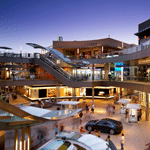In 2010, Santa Monica Place was transformed from a claustrophobic indoor mall to an open-air shopping destination. It was a massive and applause-worthy undertaking, yet not even Macerich, the property’s developer could have imagined the success of the metamorphosis.
“We always have a fiduciary responsibility to be cost-effective and sensible in what we do,” says Jeff Bedell, vice president of sustainability at Macerich. “With Santa Monica Place, all those things really came into line, and we achieved the type of development we envisioned.” The open-air Santa Monica Place, in the heart of Santa Monica, California, received LEED Gold certification, and all its sustainable elements make it a perfect place to go shopping while spending the day outdoors.
“The efforts started at the design table and early in the conceptual work,” Bedell says. Those efforts paid off because Santa Monica Place received five points in LEED’s Materials and Resources category due to its dedicated reuse of building elements, construction-waste management, and use of certified wood. More than 90 percent of construction waste was diverted from landfills. “It was looked at carefully [regarding] how and what could remain and be reused,” Bedell says. “It would have been quite easy to bulldoze everything and start from scratch.”

The three-story, 550,000-square-foot shopping center was designed by renowned architect Frank Gehry.
During construction, 90 percent of construction waste was diverted from landfills, and the shopping center has water-efficient landscaping and a green roof element.
The common areas incorporate a mix of concrete applications and aggregate, and most of them were created with recycled content. Macerich reused the existing structure and used recycled steel for the bones of the project. On those bones, it added low-VOC materials, paint, adhesives, and drywall “to ensure it’s a healthy environment for guests and people who work there long-term,” Bedell says. Macerich also installed an energy-efficient HVAC system, lighting, and controls systems, and the company provided tenant criteria packages, which pushed retailers to strive for greater energy efficiency. “The types of lights selected were not only for aesthetic impacts for design, but also for efficiency,” Bedell says.
Indeed, Macerich used various lighting types on the project, including metal halide, LED, induction, and T5 fluorescents. “It was a matter of selecting the best output and highest efficiency,” says Bedell. “Was it a hallway, a parking structure, ambient light, or an accent light? We truly have a mix of almost any and all high-efficiency sources you can think of.” LED bulbs, for instance, are found in various accent and decorative applications such as signage and backlit displays.
The technological backbone and controls in the operating systems allow Macerich to continue monitoring the development’s energy use. Keeping track of what’s running and how it’s running on a day-to-day basis is the only way to ensure the design intents are intact. “It’s easy to design a building and implement systems,” Bedell says, “then several years later, they’re running amok, and you’re not quite sure what they’re doing or how they’re doing as far as efficiency or optimization. We wanted to have that ongoing monitoring capability to be able to set those benchmarks, set those thresholds, and make sure that we not only met design intent and efficiencies the day the mall opened, but we wanted to make sure we were meeting those optimal levels of operation 10 years down the road.”
The original structure featured numerous waterfalls, but Macerich tore them down to divert the water for use in irrigation, bathrooms, and cleaning. The company strove to design and implement a system to make sure it doesn’t over-water. “Watering the sidewalk—not a good idea,” Bedell says, referring to that most common result of poor planning. “The systems need to be designed properly to ensure there isn’t waste.” Macerich reduced irrigation needs by 60 percent compared to the previous indoor space, and by installing automatic fixtures, low-flow toilets, and waterless urinals—as well as Dyson Airblade hand dryers—it reduced bathroom water use by 42 percent.
Santa Monica Place’s transformation won a handful of prestigious design awards, but the most coveted was the International Council of Shopping Centers 2012 Design Development Award for Sustainability.

